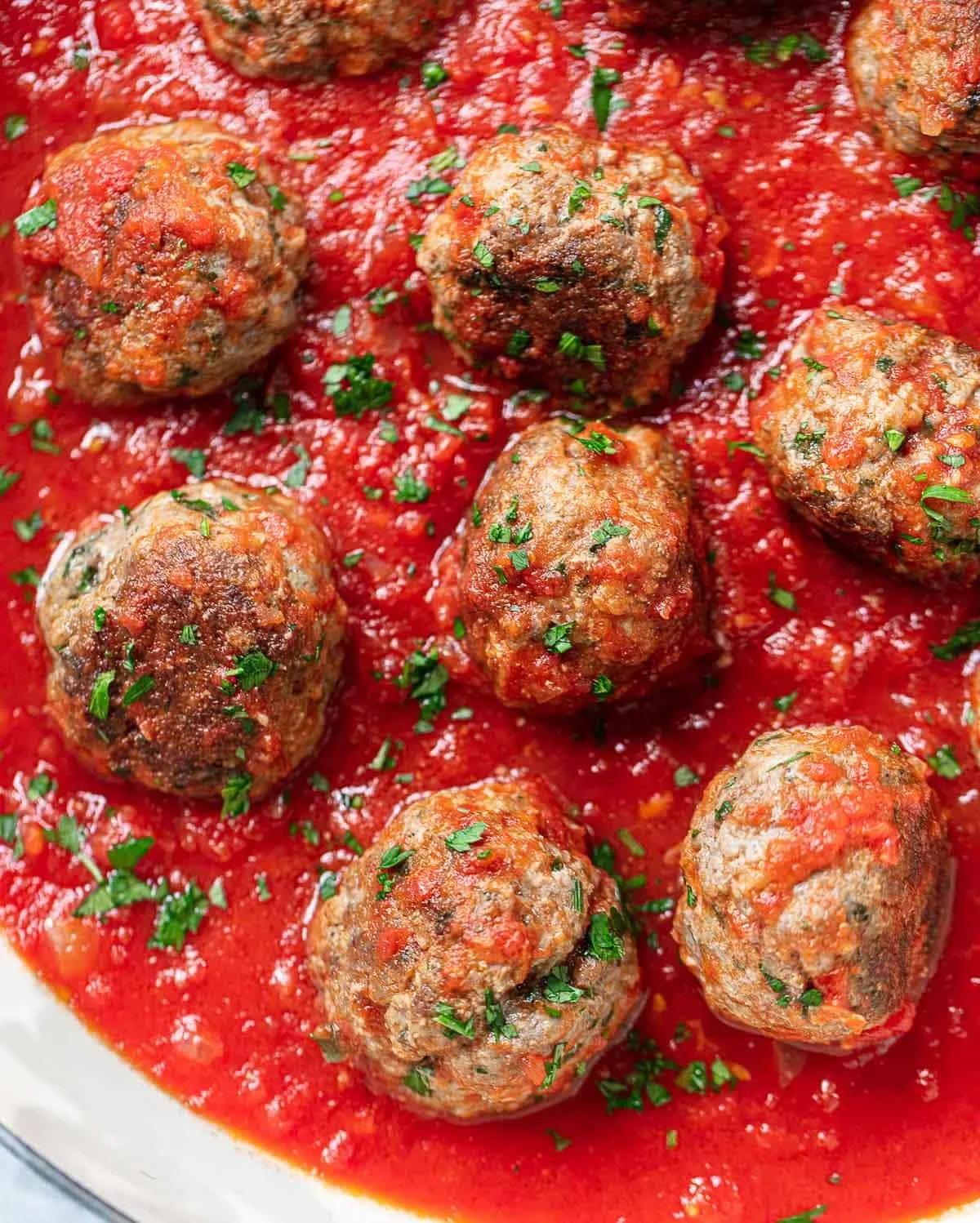Table of Contents
Ever bite into a meatball and find it... dry? Like a tiny, flavorless hockey puck? Yeah, that's a common kitchen disappointment. Nobody wants that. We're aiming for tender, juicy perfection that melts in your mouth and makes your sauce sing. The good news? Achieving that dreamy texture isn't some culinary magic trick reserved for Nonna. It often comes down to one simple ingredient you likely already have in your fridge: milk.
Why Use Milk in Your Italian Meatball Recipe?

Why Use Milk in Your Italian Meatball Recipe?
Alright, let's cut to the chase. You've seen "milk" on ingredient lists for meatballs and maybe thought, "Huh? Isn't that for cereal?" Or perhaps you just skipped it, figuring it couldn't matter *that* much. But trust me, including milk in your italian meatball recipe with milk is a game-changer. Think of it as giving your ground meat a little spa treatment. The milk, often soaked into breadcrumbs (a process called panade), adds crucial moisture. As the meatballs cook, that moisture helps keep the proteins from tightening up too much, resulting in a far more tender bite instead of something dense and dry. It's like the difference between a well-hydrated sponge and a brick.
Gathering the Right Ingredients for Tender Meatballs

Gathering the Right Ingredients for Tender Meatballs
Choosing Your Meat Mix Wisely
first things first: the foundation. You can't build a great meatball on crummy meat. For an authentic Italian vibe and maximum juiciness, you really need a mix. Straight beef? Too lean, often dry. Straight pork? Maybe a bit too fatty for some, though definitely moist. The sweet spot, the classic move, is a blend of ground beef and ground pork. Aim for something around an 80/20 lean-to-fat ratio for the beef. The pork brings moisture and a different layer of flavor that beef alone just can't replicate. Some folks even throw in a little ground veal for extra tenderness and a lighter color, but beef and pork are non-negotiable for that classic taste and texture in your italian meatball recipe with milk.
The Breadcrumb-Milk Magic (The Panade)
This is where the milk really shines and forms the heart of the moisture-boosting trick. You're making what chefs call a "panade." It's essentially stale or dried bread (usually breadcrumbs, but sometimes torn bread) soaked in liquid, which in this case, is milk. This soaked mixture acts like tiny sponges throughout the meatball, holding onto moisture during cooking. Don't just dump dry breadcrumbs in; let them soak up the milk for a few minutes until they're soft and mushy. This step is critical for preventing those dry, crumbly meatballs.
- Ground Beef (80/20 suggested)
- Ground Pork
- Dried Breadcrumbs
- Whole Milk (don't skimp on the fat!)
- Eggs (the binder)
- Parmesan Cheese (freshly grated is best)
- Onion (finely minced or grated)
- Garlic (minced)
- Fresh Parsley (chopped)
- Salt
- Black Pepper
- Optional: Pinch of red pepper flakes for a little kick
Flavor Builders and Binders
Beyond the meat and the panade, you need flavor and something to hold it all together. Eggs are your primary binder; they help the meatballs keep their shape. Then come the flavor powerhouses: finely grated or minced onion, plenty of fresh minced garlic, and a generous amount of freshly grated Parmesan cheese. Don't use the pre-shredded stuff in a can; it has anti-caking agents that mess with texture and flavor. Fresh parsley adds a bright, herbaceous note that cuts through the richness. And of course, salt and pepper are non-negotiable. Season generously, but remember the Parmesan is salty, so taste and adjust.
Mixing and Forming Your Italian Meatball Recipe with Milk

Mixing and Forming Your Italian Meatball Recipe with Milk
The Gentle Art of Mixing Meatball Magic
you've got all your beautiful ingredients lined up – the meat mix, that crucial panade (remember the milk!), the cheese, the herbs. Now comes the mixing part, and this is where many people mess up. The biggest mistake? Overmixing. Think of it like making a pie crust; you want to bring everything together just enough. If you handle the meat mixture too much, it gets tough and dense. Use your hands – they're the best tools here – but be gentle. Fold the ingredients together until they are just combined. You shouldn't be kneading it like bread dough. The goal is a cohesive mixture where everything is distributed, not a paste.
Rolling Out the Red Carpet (or Meatballs)
Once your mixture is ready, it's time to form the meatballs for your perfect italian meatball recipe with milk. The size is up to you, but consistency is key for even cooking. A common size is about 1.5 to 2 inches in diameter – roughly the size of a golf ball or a little smaller. Wet your hands slightly with water or olive oil before you start; this prevents the mixture from sticking to you and helps you get a smoother surface on the ball. Roll them gently between your palms until they are round. Don't pack them too tightly. A light touch keeps them tender.
- Use your hands for mixing, but be gentle.
- Mix just until ingredients are combined, avoid overworking.
- Wet hands slightly before rolling to prevent sticking.
- Aim for consistent size (1.5-2 inches is standard).
- Roll gently; don't pack the meatball too tightly.
Cooking Methods for Perfect Italian Meatballs

Cooking Methods for Perfect Italian Meatballs
you've got your perfectly formed, tender-in-the-making meatballs, thanks to that crucial milk-infused panade. Now what? You can't just stare at them. Cooking is the next hurdle, and you've got options. Some purists swear by frying them first for that crispy exterior, a technique that adds a layer of flavor but also... well, grease and splatter. Others go straight into simmering sauce, letting them cook low and slow, absorbing all that tomato goodness. Then there's baking, which is arguably the easiest and cleanest method. It gives you a nice even brown without constant flipping or oil burns. Each method has its merits, and the best one really depends on your desired texture and how much cleanup you're willing to tolerate.
Serving and Storing Your Delicious Creations

Serving and Storing Your Delicious Creations
Making Mealtime Magic Happen
you've done it. Your kitchen smells amazing, filled with the savory aroma of perfectly cooked meatballs from your italian meatball recipe with milk. Now comes the best part: eating them. Don't just dump them on a plate. Serve these beauties right. The classic move is, of course, nestled in a rich marinara or simple tomato sauce, piled high over spaghetti or linguine. But don't stop there. They're fantastic on a crusty sub roll, smothered in provolone for a killer meatball sub. Or try them over creamy polenta, maybe alongside some roasted broccoli rabe. They're versatile little flavor bombs.
Cooling Down Before Packing Away
Unless you plan on eating the entire batch in one sitting (and no judgment if you do!), you'll likely have leftovers. Resist the urge to just shove the hot pot of meatballs and sauce directly into the fridge. That's a recipe for food safety issues and can warm up everything else in your refrigerator, which isn't ideal. Let the meatballs cool down first. Spread them out on a plate or shallow container until they are just warm, not steaming hot. This rapid cooling is important before you seal them up.
- Serve hot, directly from the sauce if possible.
- Classic pairings: spaghetti, linguine, marinara sauce.
- Beyond pasta: meatball subs, polenta, gnocchi.
- Ensure meatballs are cooled completely before storing.
- Avoid sealing hot food in containers for refrigeration.
Storing for Later Enjoyment
Once they've cooled properly, you can store your meatballs. For short-term storage, pop them into an airtight container and keep them in the refrigerator. They'll stay good for about 3-4 days. If you've made a big batch and want to save some for a rainy day (or just a busy weeknight), freezing is your friend. You can freeze them cooked, either plain or in sauce. Lay cooled, plain meatballs on a baking sheet to freeze individually, then transfer to a freezer bag or container. If freezing in sauce, just pour the cooled mixture into freezer-safe containers. They'll keep well in the freezer for up to 3 months. Just thaw them in the fridge overnight or gently reheat from frozen in sauce when you're ready for another delicious meal.
Mastering Your Meatballs
So there you have it. The secret wasn't some expensive cut of meat or a mystical spice blend you can only find in a hidden Italian village. It's the simple addition of milk to your binding ingredients. This approach to an italian meatball recipe with milk consistently delivers a softer, more yielding texture than recipes that rely solely on breadcrumbs and egg. Give it a shot, and you'll likely find your dry meatball days are firmly in the rearview mirror. Your pasta, and anyone you're feeding, will thank you.